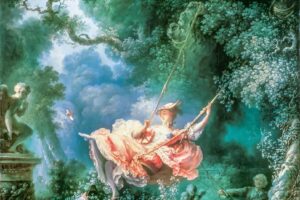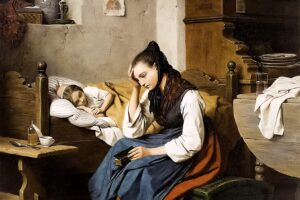Overview
The Forerunner (1920) by Eleanor Fortescue-Brickdale is a luminous celebration of vision, invention, and imagination. The painting depicts Leonardo da Vinci demonstrating a model of a flying machine before the court of Ludovico Sforza in Renaissance Milan. Surrounded by courtiers in dazzling costume, Leonardo stands in black robes, his white beard flowing, holding a fragile wooden prototype aloft.
Brickdale, often described as the last great Pre-Raphaelite, painted this canvas at a time when aviation was transforming the modern world. By turning back to Leonardo, she linked contemporary achievements to Renaissance foresight. The Forerunner is both a tribute to da Vinci’s genius and a meditation on the timeless nature of human invention.
The Story Behind the Painting
Leonardo da Vinci and His Dream of Flight
Leonardo da Vinci (1452–1519) was not only a painter but also a visionary engineer. His notebooks are filled with studies of flying machines — ornithopters, gliders, and parachutes — centuries ahead of their time. Though never realized in his day, these inventions anticipated modern aviation.
In Brickdale’s painting, Leonardo presents one of these designs before the Milanese court. The work captures both the audacity of his ideas and the wonder they inspired.
Eleanor Fortescue-Brickdale’s Vision
Eleanor Fortescue-Brickdale (1872–1945) was deeply inspired by the Pre-Raphaelite Brotherhood, especially by Edward Burne-Jones. Known for her allegorical and historical works, she sought to bridge the 19th-century Pre-Raphaelite style with early 20th-century themes. The Forerunner is among her most ambitious works, completed at a time when airplanes had recently reshaped warfare and exploration.
A Timely Symbolism
Painted in 1920, the work was a reflection on how past visionaries shape the future. In the aftermath of World War I — where flight had played a transformative role — Leonardo’s dream took on renewed significance.
Composition and Subjects
Leonardo at the Center
At the heart of the canvas, Leonardo da Vinci stands in solemn black, holding aloft his wooden flying machine. His expression is contemplative, his posture steady, as though aware that his vision transcends his age.
The Courtiers
Around him, richly dressed courtiers react with curiosity, amusement, or contemplation. Some lean forward, others exchange glances, each response reflecting the tension between skepticism and awe. Their Renaissance costumes shimmer in reds, golds, and patterned fabrics, painted with Pre-Raphaelite precision.
Ludovico Sforza and the Court
Seated to the left is Ludovico Sforza, Duke of Milan, accompanied by noblewomen in elaborate gowns. Their presence grounds the scene historically, reminding us that Leonardo worked under Sforza’s patronage.
The Child Observer
At Leonardo’s feet stands a young boy, gazing upward with wonder. He embodies the future — a symbol of generations who would one day see the dream of flight realized.
Decorative Backdrop
Behind the figures, arched columns reveal fresco-like murals depicting scenes of human striving. They serve as a reminder of continuity, linking Leonardo’s invention to the long tradition of human aspiration.
Art Style and Techniques
Pre-Raphaelite Influence
Brickdale employs jewel-like colors, sharp outlines, and detailed textures, hallmarks of Pre-Raphaelite art. The elaborate costumes, patterned tiles, and symbolic details show her fidelity to the Brotherhood’s ideals even in the 20th century.
Historical and Allegorical Fusion
While firmly rooted in Renaissance history, the painting functions allegorically. Leonardo is presented not just as an inventor but as the forerunner of all who dream beyond their time.
Symbolic Light and Color
Warm golden light floods the scene, emphasizing Leonardo’s model and the young boy’s gaze. The balance of reds, blacks, and golds heightens the sense of ceremony and vision.
Legacy and Reflection
A Bridge Between Eras
The Forerunner is one of Brickdale’s most enduring works, embodying her ability to merge Pre-Raphaelite aesthetics with themes relevant to the modern world. By painting Leonardo in 1920, she honored both the Renaissance past and the dawning age of aviation.
Enduring Meaning
The painting resonates today as a reminder of human vision and perseverance. Leonardo’s fragile model becomes a symbol of all dreams that seem impossible until realized. In Brickdale’s hands, the dream of flight is not only history but destiny.
Leonardo lifts his fragile model, courtiers watch in wonder, a child looks upward with hope. In that moment, Eleanor Fortescue-Brickdale shows us not just the Renaissance but the eternal truth of human aspiration — that every dream has its forerunner.
This Painting Featured in (Pre-Raphaelite 1 Spot the Difference Puzzles: Interactive, Printable Flipbook) by Classic Art Puzzles.



